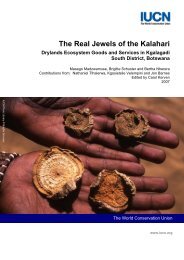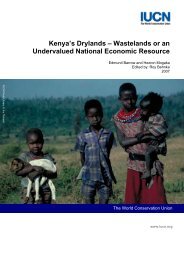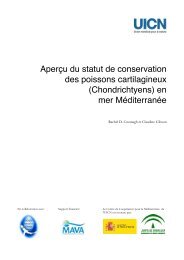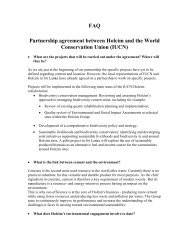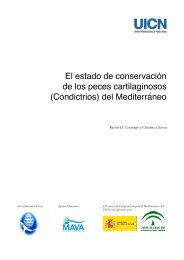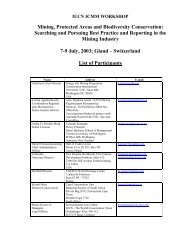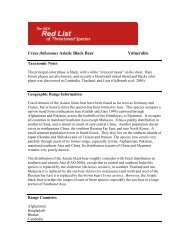iucn mediterranean sharks (pdf) - The Shark Trust
iucn mediterranean sharks (pdf) - The Shark Trust
iucn mediterranean sharks (pdf) - The Shark Trust
You also want an ePaper? Increase the reach of your titles
YUMPU automatically turns print PDFs into web optimized ePapers that Google loves.
al. 2005). Unfortunately, data collected are incomplete andsome of the most important landings are not recorded due toseveral species being reported under one group. For example,only thornback ray Raja clavata has separate records dataamong the Rajids. Additionally, FAO data only report officiallandings and therefore bycatch returned to the sea is notincluded (Walker et al. 2005). Several species, (e.g. commonskate Dipturus batis, sawback angelshark Squatina aculeataand smoothback angelshark S. oculata) are now consideredlocally extirpated or commercially extinct in theMediterranean. Exploitation of such species continues,however, as they constitute bycatch in many other fisheries(Walker et al. 2005).Although directed fisheries have caused stock collapsefor some species, more significant threats tochondrichthyans are mortality in mixed species fisheriesand bycatch in fisheries targeting more valuable species(Musick and Bonfil 2005; Stevens et al. 2005). <strong>The</strong>re areno Mediterranean pelagic fisheries that target migratoryoceanic <strong>sharks</strong>. However, longline fisheries targetingswordfish and tunas (which have increased in effort overthe past three decades) pose a great threat to susceptiblechondrichthyans taken as bycatch in this fishery (ICCAT2001). Bycatch is poorly documented and data are rarelyincorporated into national and international (FAO)statistics, therefore numbers of <strong>sharks</strong> caught as bycatchcan only be crudely estimated (Camhi et al. 1998).Driftnetting catches large numbers of chondrichthyans.This fishing method, once used widely throughout theMediterranean, is now prohibited here (see 6.2), howeverillegal driftnetting still occurs (WWF 2005).Chondrichthyans most vulnerable and frequently caughtwith driftnets include blue shark Prionace glauca,common thresher Alopias vulpinus, shortfin mako Isurusoxyrinchus, porbeagle Lamna nasus, basking sharkCetorhinus maximus, giant devil ray Mobula mobular,pelagic stingray Pteroplatytrygon violacea, requiem<strong>sharks</strong> Carcharhinus spp. and hammerheads Sphyrnaspp. (Tudela 2004; Walker et al. 2005).Recreational sport fisheries have increased noticeably overthe past few years, particularly off the Italian, Spanish andFrench coasts. Although data are limited, target speciesmainly include thresher <strong>sharks</strong> Alopias spp. and blue sharkPrionace glauca, with catches primarily composed ofyoung individuals. Anglers are increasingly releasing theircatches alive (SGRST 2003; Walker et al. 2005).1.2.3 Habitat loss, environmental degradationand pollutionPressures resulting from human population growth alongthe coastline are detrimentally affecting the marineecosystem and are contributing to the threats faced bychondrichthyans. Rapid urban and industrial developmentand associated pollution have degraded critical coastalhabitats, such as nursery and spawning areas (Camhi et al.1998; Stevens et al. 2005; UNEP MAP RAC/SPA 2003).Fisheries activities such as intensive bottom-trawling reducethe complexity of benthic habitats, affecting the epiflora andepifauna and reducing the availability of suitable habitats forpredators and prey (Stevens et al. 2005). Pollution cancontaminate food sources, concentrating in animals at thetop of the food chain and potentially affecting physiologyand functioning (UNEP MAP RAC/SPA 2003). A number ofstudies have shown that some Mediterranean <strong>sharks</strong>, such asthe spiny dogfish Squalus acanthias, contain illegally high(>0.50mmg/kg) concentrations of mercury. Trace metals andorganochlorine residues have been found in the eggs, muscles,liver and kidneys of deepsea <strong>sharks</strong> such as gulper sharkCentrophorus granulosus and blackmouth catshark Galeusmelastomus, confirming that deepwater species are also beingaffected by pollution (UNEP RAC/SPA 2002).1.3 Management implicationsDue to their life history characteristics, it is not appropriateto apply conventional management models of teleost fisheriesto chondrichthyan populations, and the need for aprecautionary approach to their management has beenrepeatedly highlighted (e.g. in FAO 2000; Fowler andCavanagh 2005a). International and regional conventionsand agreements relevant to Mediterranean chondrichthyansare discussed in section 5 of this report. Protection has beengranted to a very small number of shark and ray species andsome fishing restrictions are in force. <strong>The</strong>se restrictions areoften unsatisfactory, however. In general, the managementtechniques and enforcement measures currently in place areinadequate to ensure the long-term survival of many speciesand populations (Camhi et al. 1998; Fowler andCavanagh 2005a).1.4 <strong>The</strong> IUCN Red List of ThreatenedSpecies TM – a tool for management<strong>The</strong> IUCN Red List of Threatened Species TM (IUCN Red List) iswidely recognised as the most comprehensive, scientificallybasedsource of information on the global status of plant andanimal species. IUCN Red List Categories and Criteria areapplied to individual species assessments (which containinformation on aspects such as ecology and life history,distribution, habitat, threats, current population trends andconservation measures), to determine their relative threat ofextinction. Threatened species are listed as CriticallyEndangered (CR), Endangered (EN) or Vulnerable (VU). Taxathat are either close to meeting the threatened thresholds orwould be threatened were it not for ongoing conservationprogrammes are classified as Near Threatened (NT). Taxaevaluated as having a low risk of extinction are classified as3



